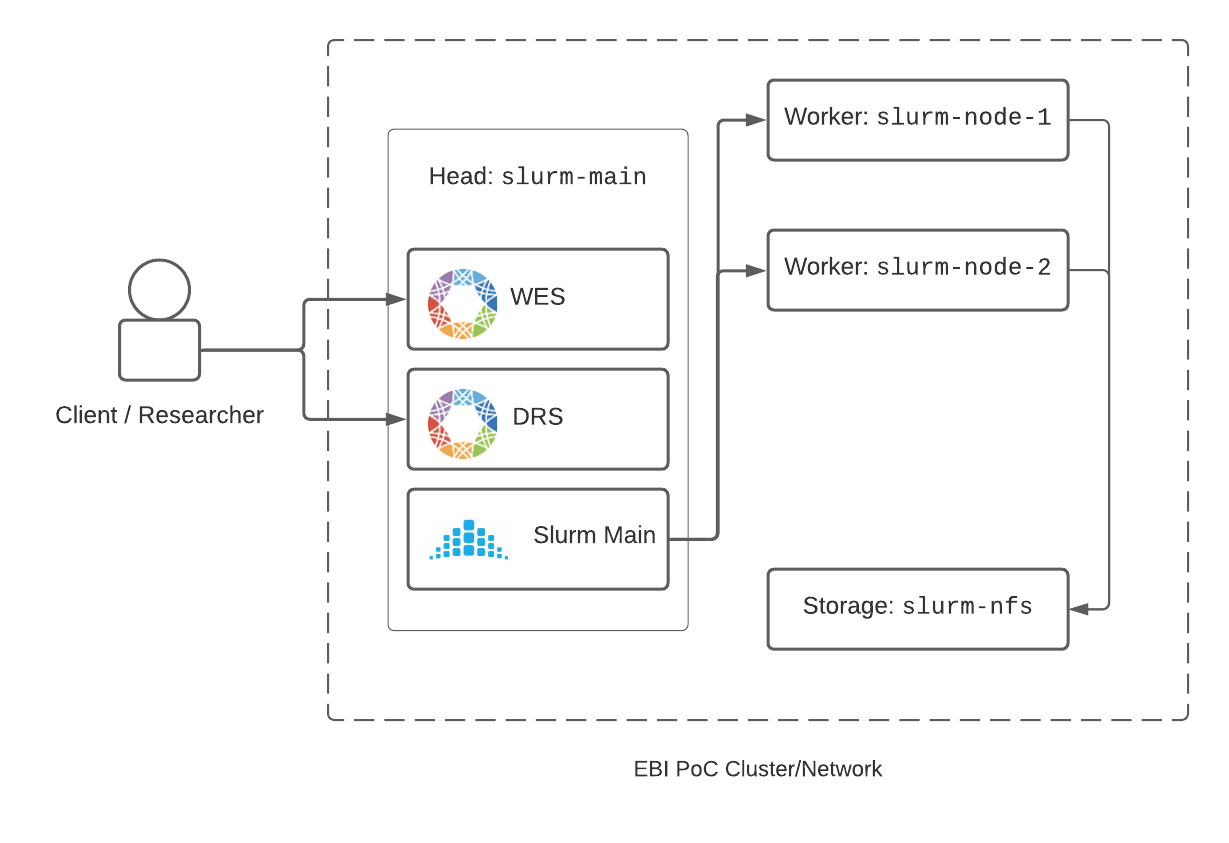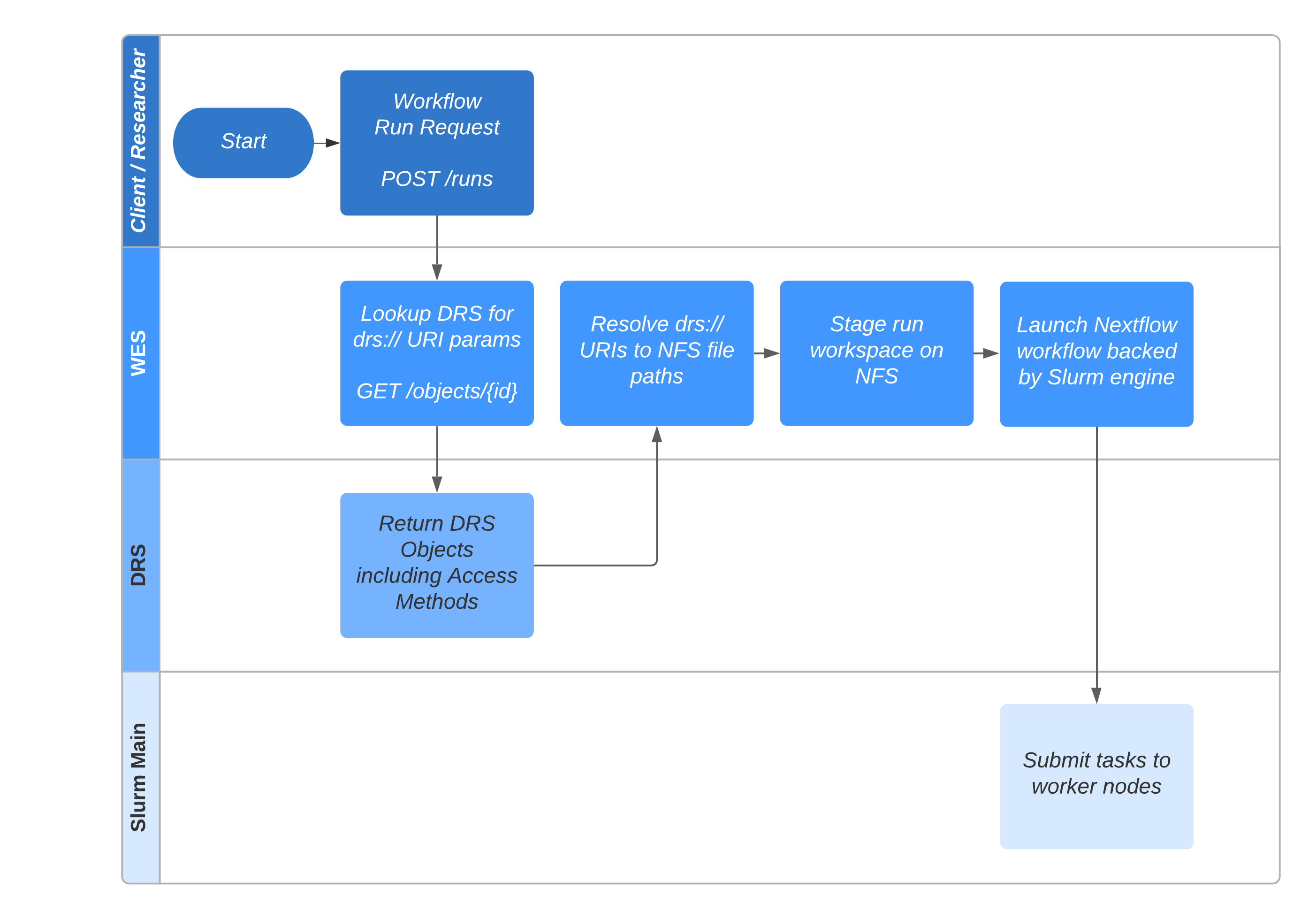CNest workflow at EBI
For this demo, we set up the Starter Kit implementations of WES and DRS on a mini-cluster at the European Bioinformatics Institute (EBI), resembling a massively scaled-down version of the core HPC cluster. We connected WES to a Slurm engine, and ran a novel Copy Number Variation and Association workflow, CNest, using API Calls to WES. DRS resolved paths to the input files on an NFS node, enabling us to run the workflow with DRS URIs as input rather than hardcoded paths.
The CNest Workflow
CNest is a novel method for copy number variation (CNV) analysis from next generation sequencing (NGS) data. For more information about CNest, see:
Starter Kit Setup and Workflow Execution
As mentioned, the goal for this demo was to successfully run the Nextflow-based CNest workflow via a Slurm cluster backend, using API calls made to WES from a hypothetical researcher.
Given our requirements, EBI Cluster Services set up a mini-cluster of 4 nodes:
slurm-main: A main node functioning as the Slurm orchestrator, can delegate computational tasks to worker nodesslurm-node-1: A first Slurm worker node to perform jobs submitted to it by the main nodeslurm-node-2: A second Slurm worker node, functionally identical to the firstslurm-nfs: A 30+ TB storage instance to store the input files (CRAMs and indexes) for the workflow
WES and DRS instances were also spun up on the slurm-main node. slurm-main thus acted as the "internet-facing" node for the cluster, receiving WES and DRS API calls from a remote researcher. Figure 1 displays a high-level overview of the mini-cluster architecture.
 Figure 1: Architecture of proof-of-concept mini-cluster used to run CNest workflow via Slurm using WES and DRS.
Figure 1: Architecture of proof-of-concept mini-cluster used to run CNest workflow via Slurm using WES and DRS.
DRS Setup
The database backing the DRS instance was loaded with the following DRS Objects:
- A single, root bundle, representing the root of the entire project dataset
- A bundle for each individual in the dataset, containing a child blob for each file associated with the individual
- A blob-based DRS Object for each CRAM file
- A blob-based DRS Object for each CRAM index (CRAI) file
Each DRS Object representing a CRAM or CRAI file was associated with the file path to the raw data on the NFS node. This information was relayed back to the client as a file:// based access_method in the access_methods array.
Workflow Submission
Workflow run submission was initially triggered by a POST /runs API call to WES.
For this demo, the researcher was not expected to have knowledge of raw file paths to input CRAM and CRAI files. Rather, they were assumed to have knowledge of the DRS URIs representing the DRS Objects for these inputs. The researcher thus submitted DRS URIs as part of the workflow_params payload to WES.
Upon receiving the workflow run request, WES interpreted the DRS URI workflow_params (i.e. starting with drs://) as requiring resolution. WES, acting as a client, made API calls to DRS, and resolved the file paths to the raw data (on the NFS node) based on the single access_method returned by the DRSObject. WES staged the run by substituting in the resolved file paths as inputs to the Nextflow workflow.
Following this, the workflow was launched via Nextflow, using Slurm as the job engine. Figure 2 illustrates the downstream events triggered, such as input path resolution and run submission, by the initial researcher workflow request to WES.
 Figure 2: Steps to launching CNest workflow upon API call to WES, including input path resolution via DRS.
Figure 2: Steps to launching CNest workflow upon API call to WES, including input path resolution via DRS.
Outcomes
Coming soon
Future Directions
Coming soon
Acknowledgements
The GA4GH Engineering Team would like to thank the following individuals for making this demo possible:
- Tomas Fitzgerald
- Shimin Shuai
- Mohamed Alibi
- Rafa Grimán Canto
- Tim Dyce